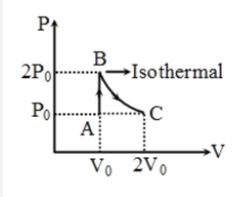A monatomic gas undergoes a thermodynamic process such that T∝V−27 (T = temperature and V = volume of the gas) As heat is supplied to the gas, choose INCORRECT option.
ms velocity of gas molecules increases
rms velocity of gas molecules decreases
work done on the gas is positive
density of the gas increases
The correct Answer is:B
To solve the problem, we need to analyze the thermodynamic process of a monatomic gas under the given condition that temperature T is proportional to V−2/7. We will derive relationships and determine the incorrect option based on the implications of supplying heat to the gas.
1. Understanding the Relationship:
Given that T∝V−2/7, we can express this as:
T=k⋅V−2/7
where k is a constant.
2. Rearranging the Equation:
To eliminate T, we can multiply both sides by V2/7:
T⋅V2/7=k
This indicates that T⋅V2/7 remains constant.
3. Using the Ideal Gas Law:
From the ideal gas law, we know:
PV=nRT
Rearranging gives:
T=PVnR
4. Substituting for T:
We can substitute T from the ideal gas law into our earlier equation:
PVnR⋅V2/7=k
Simplifying gives:
PV9/7=nRk
This indicates that PV9/7 is also a constant.
5. Analyzing Heat Transfer:
When heat Q is added to the system, the first law of thermodynamics states:
Q=ΔU+W
where ΔU is the change in internal energy and W is the work done by the gas.
6. Change in Internal Energy:
For a monatomic gas, the change in internal energy is given by:
ΔU=32nRΔT
7. Work Done by the Gas:
The work done by the gas can be expressed as:
W=PΔV
Using the relationship from earlier, we can find how W changes with ΔT.
8. Determining the Effect of Heat:
As heat is supplied, the temperature T increases. However, since T is proportional to V−2/7, an increase in T implies a decrease in V (the volume must decrease to maintain the relationship).
9. Density Consideration:
Density ρ is defined as:
ρ=mV
If the volume decreases while mass remains constant, the density increases.
10. Identifying the Incorrect Option:
Based on the analysis:
- If the gas expands, the work done by the gas is positive.
- If the temperature decreases, the RMS velocity decreases.
- If the volume decreases, the density increases.
Therefore, the incorrect statement would be the one that suggests that the density of the gas decreases when heat is supplied.
Given that T∝V−2/7, we can express this as:
T=k⋅V−2/7
where k is a constant.
To eliminate T, we can multiply both sides by V2/7:
T⋅V2/7=k
This indicates that T⋅V2/7 remains constant.
From the ideal gas law, we know:
PV=nRT
Rearranging gives:
T=PVnR
We can substitute T from the ideal gas law into our earlier equation:
PVnR⋅V2/7=k
Simplifying gives:
PV9/7=nRk
This indicates that PV9/7 is also a constant.
When heat Q is added to the system, the first law of thermodynamics states:
Q=ΔU+W
where ΔU is the change in internal energy and W is the work done by the gas.
For a monatomic gas, the change in internal energy is given by:
ΔU=32nRΔT
The work done by the gas can be expressed as:
W=PΔV
Using the relationship from earlier, we can find how W changes with ΔT.
As heat is supplied, the temperature T increases. However, since T is proportional to V−2/7, an increase in T implies a decrease in V (the volume must decrease to maintain the relationship).
Density ρ is defined as:
ρ=mV
If the volume decreases while mass remains constant, the density increases.
Based on the analysis:
- If the gas expands, the work done by the gas is positive.
- If the temperature decreases, the RMS velocity decreases.
- If the volume decreases, the density increases.
Similar Questions
A certain amount of an ideal monoatomic gas undergoes a thermodynamic process such that VT2= constat where V= volume of gas, T= temperature of gas. Then under process
View SolutionOne mole of a diatomic gas undergoes a thermodynamic process, whose process equation is P∝V2. The molar specific heat of the gas is
View SolutionAn ideal gas (γ=1.5) undergoes a thermodynamic process in which the temperature and pressure of the gas are related as T−1P2= constant. The molar heat capacity of the gas during the process is
View Solution1 mol of an ideal gas undergoes different thermodynamical process in P−V digram given below :

If temperature at point C is TK then :
View SolutionIn a process V∝T2, temperature of 2 moles of a gas is increased by 200K. Work done by the gas in this process will be
View SolutionAn ideal monoatomic gas follows a thermodynamic process as shown in pressure-volume (P-V) plot. The work done in process AB is

View SolutionTwo moles of an ideal mono-atomic gas undergoes a thermodynamic process in which the molar heat capacity 'C' of the gas depends on absolute temperature as C=RTT0, where R is gas consant and T0 is the initial temperature of the gas. (V0 is the initial of the gas). Then answer the following questions:
The equation of process is
View SolutionIf a monoatomic gas undergoes a thermodynamic proces for which its molar heat capacity is equal to the universal gas constant. What is the process in terms of V and T ?
View SolutionAn ideal diatomic gas undergoes a thermodynamic process as shown in the P−V diagram. The process AB is isochoric while the process BC is isothermal. The total heat gein to the gas in the process is nearly (use ln2=0.7)

View SolutionTwo moles of an ideal mono-atomic gas undergoes a thermodynamic process in which the molar heat capacity 'C' of the gas depends on absolute temperature as C=RTT0, where R is gas consant and T0 is the initial temperature of the gas. (V0 is the initial of the gas). Then answer the following questions:
The minimum volume of gas is
View Solution
